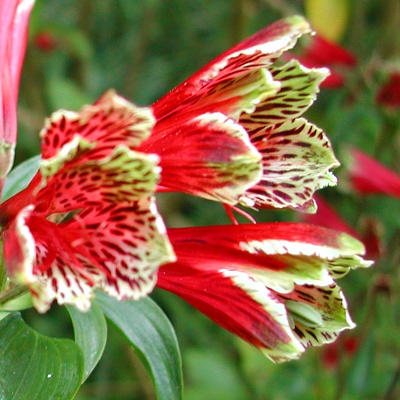"Parrot Lily"
Be careful when handing the tubers, to avoid breaking them off Getting started -- I recommend starting your plant in a 1-2 gallon pot (4-8 liters). If you received a plant, and not dormant tubers, give it filtered sun for the first week, and then increase the sun by an hour or two every few days. Avoid strong afternoon sun the first month. Soil -- The Parrot Lily does best in
well-draining soil that is high in organic matter. A typical mix is 2 parts potting soil Bury your plant an inch deeper in the soil than it was grown. If you received bare tubers, plant them about 2-3 inches (5-8 cm) deep. Don't compress the soil after planting. Watering -- The Parrot Lily prefers soil that's consistently moist but not soggy. Don't allow the soil to dry out or it may go
dormant. If you're unsure if the soil is moist enough, use a moisture meter Planting out -- Once your plant has grown in a 1 gallon container for a month or two, it can be planted in the ground in Zones 7-8 and above. Please note that this plant is known to be invasive, since it spreads easily by seeds, and also by offsets. You may snip off the flower heads after blooming to prevent seeds from forming, however a large bed of them will probably get out of control. For this reason you may wish to grow only a few of them. Climate - The Parrot Lily thrives in moderate temperatures. It grows well in warmer areas like the South if given filtered sun during the warmest times of the day. In warmer areas it may go dormant in the summer, and then resprout in the fall. In Zones 7 and below, it should be grown in a pot and brought indoors over the winter. In warmer zones that are prone to frost, mulch the plant well, and plant it so the tubers are 4-6 inches (10-15 cm) under ground. The plant can remain evergreen in mild-winter areas. Fertilizing -- During periods of active growth, feed
about every 2 months with a general-purpose fertilizer (I use
this) Bugs to watch for -- Aphids (green ones are hard to see), caterpillars, slugs & snails. If you have any questions or problems, please email me. Enjoy your plant! - Jeff Strange Wonderful Things
|
|||||||||


